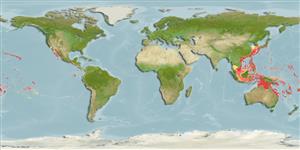Environment: milieu / climate zone / depth range / distribution range
Ecología
marino asociado a arrecife; rango de profundidad 6 - 130 m (Ref. 89972). Subtropical; 35°N - 31°S
Pacific Ocean: antitropical, from southern Japan, Hawaiian Islands, Clipperton Island, Revillagigedo Islands, southern California, Easter Island, and Pitcairn Islands.
Tamaño / Peso / Age
Maturity: Lm ? range ? - ? cm
Max length : 30.0 cm NG macho / no sexado; (Ref. 89467)
Espinas dorsales (total): 3; Radios blandos dorsales (total): 29-32; Espinas anales 0; Radios blandos anales: 26 - 29. Males are straw-yellow with each scale outlined in black creating a crosshatched appearance, and a red tail with neon submarginal blue band. Females are also crosshatched, but with a slate gray to blue ground color and tail.
Found mainly around oceanic islands and near reefs along the continental coasts (Ref. 9276). Found in schools in seaward reefs above drop-offs (Ref. 9710). Benthopelagic (Ref. 58302). Feeds on zooplanktons (Ref. 89972).
Males establish a territory for spawning and parental care but not for feeding (Ref. 116451). Only females tend the eggs but both parents keep guard (Ref. 116451).
Myers, R.F., 1991. Micronesian reef fishes. Second Ed. Coral Graphics, Barrigada, Guam. 298 p. (Ref. 1602)
IUCN Red List Status (Ref. 130435)
Threat to humans
Harmless
Human uses
Acuario: Comercial
Más información
ReferenciasAcuiculturaPerfil de acuiculturaRazasGenéticaElectrophoresesheritabilidadEnfermedadesProcesamientoNutrientsMass conversion
ColaboradoresImágenesStamps, Coins Misc.SonidosCiguateraVelocidadTipo de nataciónSuperficie branquialOtolitosCerebrosVisión
Herramientas
Special reports
Download XML
Fuentes de Internet
Estimates based on models
Preferred temperature (Ref.
123201): 21.1 - 29, mean 27.8 °C (based on 1418 cells).
Phylogenetic diversity index (Ref.
82804): PD
50 = 0.5078 [Uniqueness, from 0.5 = low to 2.0 = high].
Bayesian length-weight: a=0.02570 (0.01232 - 0.05364), b=2.94 (2.77 - 3.11), in cm total length, based on LWR estimates for this (Sub)family-body shape (Ref.
93245).
Nivel trófico (Ref.
69278): 4.0 ±0.28 se; based on food items.
Resiliencia (Ref.
120179): Alto, población duplicada en un tiempo mínimo inferior a 15 meses (Fec=32,000 (from an egg cluster)).
Fishing Vulnerability (Ref.
59153): Low vulnerability (18 of 100).
Nutrients (Ref.
124155): Calcium = 26.6 [10.3, 81.9] mg/100g; Iron = 0.662 [0.319, 1.736] mg/100g; Protein = 19.1 [16.9, 21.3] %; Omega3 = 0.208 [0.106, 0.407] g/100g; Selenium = 18.3 [7.9, 41.7] μg/100g; VitaminA = 56.9 [14.5, 228.7] μg/100g; Zinc = 0.584 [0.360, 0.928] mg/100g (wet weight);
